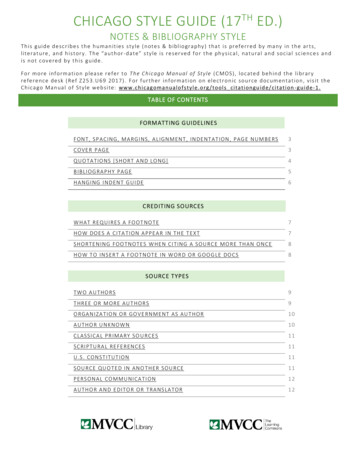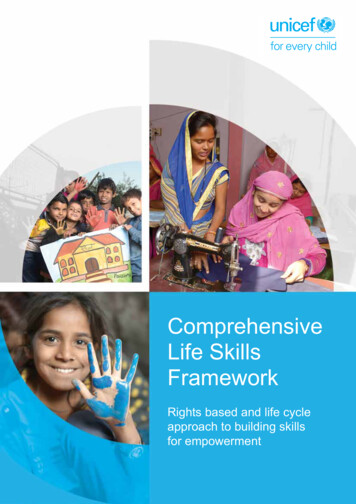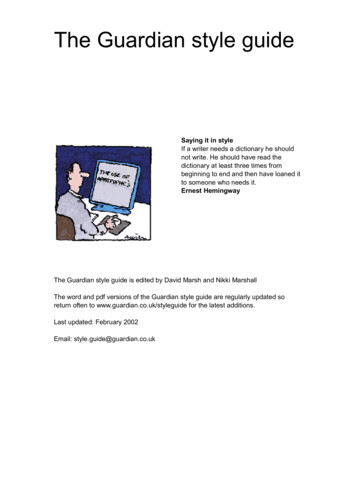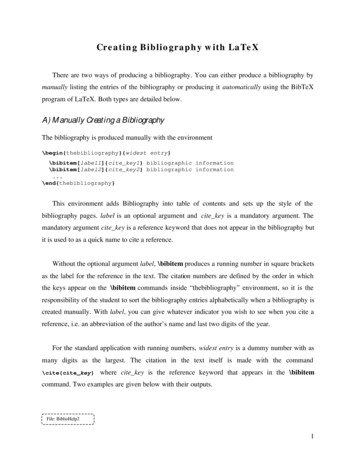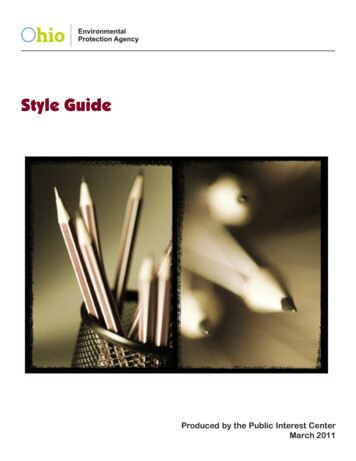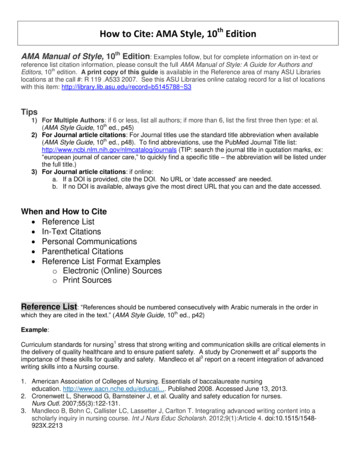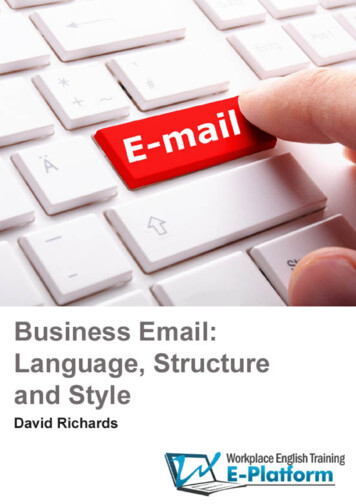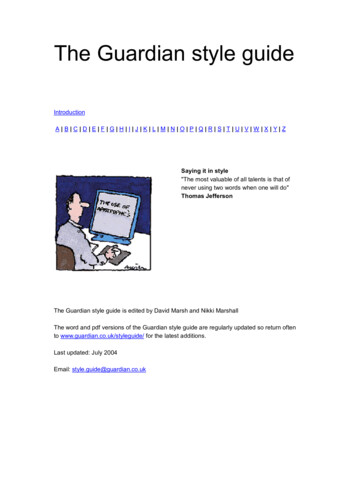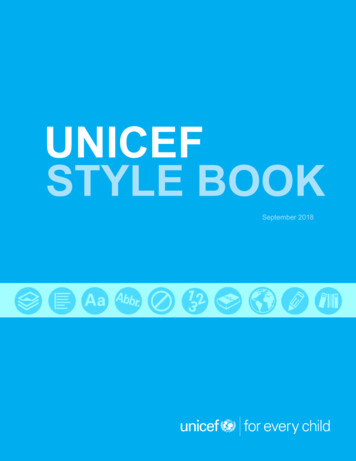
Transcription
UNICEFSTYLE BOOKSeptember 2018
UNICEFSTYLE BOOKSeptember 2018
ContentsWhy does UNICEF need a Style Book? . 4Who should follow UNICEF house style . 4About the UNICEF Style Book . 5The Basics . 6Voice . 6Spelling . 6Accents . 8Punctuation . 8Language . 11Principles of composition . 13Format . 16Capitalization . 18Capitalization of commonly used terms. 20Acronyms and abbreviations . 28Acronyms, initialisms and other abbreviations (list) . 31Troublesome issues . 45Prepositions . 45Commonly misused words and expressions . 48Numbers . 54Citations and references . 60Country and personal names . 72Personal names . 72United Nations country names . 73Note regarding country names . 81Area and territory names . 83UNICEF regional classifications . 84Country groupings (for information only) . 86Least developed countries/territories . 88World Bank country classifications, by income level . 89Definitions: Copy editor and proofreader . 90Resources . 91Permission and use . 93
Why does UNICEF need a Style Book?Good writing is important for all organizations. UNICEF faces a constant demand for information and must ensurethat its publications and other documents are professionally crafted and clearly understood, and that theyresonate with their intended audience.The UNICEF Style Book has the following objectives: To promote good writing and the highest quality editorial standards in UNICEF’s publications,documents and other materials – both printed and electronic. The Style Book provides guidance onlanguage, style, usage and rules governing writing within the organization. To promote consistent use of terminology and clarity in communications across the organization.When this is done, readers can concentrate on the substance of a document rather than be distracted byvariations in the use of spelling, grammar, punctuation and formatting. To enhance the organization’s corporate image and help promote and preserve the UNICEF brand.The quality and consistency of every communication is a reflection on the organization. The Style Book helpscreate a level of uniformity, so that information produced by several groups is shaped into one consistentvoice and appears to come from a unified source. To make the process of writing and producing documents easier. Rather than having to ‘reinvent thewheel’ with each publication, authors, editors and project managers can turn to the UNICEF Style Book tofind clarification on the recommended house standard. To provide a quick reference guide that includes information to inform the writing and editingprocess. Links to a range of ancillary documents are included in the Style Book, which help all thosewho write for the organization to produce work that meets the highest professional standards.Who should follow UNICEF house style?An established house style benefits authors, editors, programme and policy staff – as well as readers.Familiarity with and use of the UNICEF Style Book by all staff and consultants producing publications, reports,briefing documents, fact sheets, media materials and web content will help ensure that the organization’smessage is clearly understood. It will promote consistency in terminology and correct spelling across theorganization. And most importantly, it will help UNICEF speak with one voice and inspire confidence in itsprogrammes and activities.4UNICEF Style Book
About the UNICEF Style BookThis revised edition of the UNICEF Style Book provides guidance on grammar, spelling, punctuation and otherkey elements necessary to ensure consistency and clarity in UNICEF’s printed and electronic publications. It hasbeen revamped to streamline the content and to promote complementarity with the UNICEF Publication Toolkit.The Style Book is meant to be used in conjunction with other communications guidelines, such as the UNICEFPublication Toolkit and the UNICEF Brand Tool Kit. Further guidance on matters of style and terminology can befound in the following sources:Oxford Dictionaries online: www.oxforddictionaries.com/ The Chicago Manual of Style (16th or 15th edition): www.chicagomanualofstyle.org/home.html United Nations Editorial Manual: http://69.94.137.26/editorialcontrol/ United Nations Multilingual Terminology Database (UNTERM): http://unterm.un.org * Please note that UNICEF and United Nations style guidance supersede The Chicago Manual of Style.###UNICEF Style Book5
The basicsVoiceUNICEF’s voice is the tone used to express its mission to its many stakeholders. That tone should indicatethat UNICEF gets things done in ways that are: PositiveEngagingDirectAuthoritativeAll of UNICEF’s writing must convey these qualities. Generally, simplicity of expression and brevity allow forease of understanding. UNICEF’s writing must be clear, direct and precise. Therefore, the use of foreignwords, jargon and acronyms should be avoided or kept to a minimum.The writing of UNICEF’s staff and consultants, while acknowledging difficulties and challenges, should bepositive and forward-looking. Bold writing shows that the organization is confident and innovative. UNICEFseeks to engage all its stakeholders, including younger audiences. Straightforward language and acontemporary writing style will help engage children and young people.SpellingThe authority for spelling is the Concise Oxford English Dictionary. In 2013, the version in use was thetwelfth edition (Oxford University Press, Oxford and New York, 2004).When an alternate spelling is provided in the dictionary, always use the first listing, which denotes thepreferred spelling. Use the root spelling, rather than a variant, and avoid US spellings, which the dictionaryshow in parentheses: diarrhea diarrhoea endeavor endeavourHowever, respect the spelling of proper names that differ from the spelling given in the Concise Oxford EnglishDictionary. Follow the official spelling used by the relevant organization or entity. For example:‒‒Centers for Disease Control and Prevention (CDC) (not Centres)6UNICEF Style BookOrganisation for Economic Co-operation and Development (OECD) (not Organization)
Words ending in -ize, -ise and -yseThe first spelling of words ending in -ize, -ise and -yse provided in the Concise Oxford English Dictionary,twelfth edition, is to be used. Examples of the spelling of commonly used words: authorise authorize criticise criticize formalise formalize generalise generalize organisation organization advertize advertise analyze analyse catalyze catalyseButDoubling final consonantsWhen -ed or -ing is added to a word ending in a single consonant preceded by a single vowel, double the finalconsonant:allot, allotted, allottingcommit, committed, committingoccur, occurred, occurringException: benefit, benefitedPlurals for words of foreign originFor plurals of words of foreign origin, use the preferred, or first, form given in the Concise Oxford EnglishDictionary. The list below shows the prescribed plurals for nouns frequently used in United Nations isescriteriacurriculaforums (not ‘fora’)plateaustimuliUsually, the word ‘agenda’ takes a singular verb, and the word ‘data’ takes a plural verb.UNICEF Style Book7
AccentsAccents, such as those in French and Spanish, can be found in Microsoft Word by selecting ‘Insert’, ‘Symbol’, thenthe appropriate symbol. If you regularly work in languages other than English, you will need to add or modify thelanguages available to you.PunctuationPeriod [.]A period should always be followed by one space (preceding the following sentence), not two.Comma [,]In a series of three or more items with a conjunction, UNICEF style is to use a comma after each item except theone preceding the conjunction:iron, iodine and vitamin AHowever, a comma may be inserted before the conjunction when needed for clarity:The issues raised were human rights, armed conflict and military expenditure, access to information,and the needs of children living or working on the street.If the name of a country is provided after a city, the country name is enclosed in commas:The World Conference on Education for All was held at Jomtien, Thailand, in 1990.Do not allow commas in compound predicates. Make sure there is a noun in the second part of the sentence ordelete the comma: She wrote the report over the course of five months, and submitted it to the Executive Director. She wrote the report over the course of five months, and then she submitted it to the ExecutiveDirector. She wrote the report over the course of five months and submitted it to the Executive Director.Single quotation marks [‘ ’]Single quotation marks should be used to enclose titles of certain kinds of documents (see p. 61 for a complete list),themes of conferences, slogans, special terms, and words and letters used as words. Punctuation marks (otherthan those that are part of the title, phrase or term) fall outside single quotation marks:The international recognizes the need for development to have a ‘human face’.Halperin, Daniel, et al., ‘A Surprising Prevention Success: Why did the HIV epidemic decline inZimbabwe?’, PLoS Medicine, vol. 8, no. 2, February 2011.The typewriter was missing the letter ‘e’.8UNICEF Style Book
Double quotation marks [“ ”]Double quotation marks are used for quoting text or direct speech only.Depending on the type, punctuation may fall inside or outside of double quotation marks. Commas and periods –as well as question marks, exclamation points, en dashes and ellipses that are part of the quoted material –fall inside double quotation marks. Colons and semicolons, as well as punctuation marks that are not part of thequoted material, fall outside double quotation marks:She said, “Hello.”He admitted, “She is quite capable”; she elaborated, “Indeed, anything you can do, I can do better!”Do you know who said, “Written words change us all”?Quotations of 10 or more lines should be set outside of running text as block quotes. Begin these on a separateline from the preceding text, flush left (i.e., starting at the left margin). Do not use quotation marks but ensure thatproper attribution is given.All quotations used as introductory pieces or otherwise presented outside of running text should be flush left. Theattribution related to a quotation should be on a separate line, also flush left, preceded by an en dash.“The most important thing is to enjoy life – to be happy – that’s all that matters.”‒ Audrey HepburnColon [:]A colon tells the reader that what follows is closely related to the preceding clause. It is used to introduce aquotation, an explanation or an enumeration:The three goals are: protect children, help mothers and care for the elderly.A colon should always be followed by one space, not two. The word following a colon should start with a capitalletter if it begins a complete sentence or if it occurs in a headline:It was a dreadful day: The sky was dark, a foul rain battered the pavement and the smell of sulfurpermeated the air.Child Survival: Where we standSemicolon [;]Use a semicolon:1.To separate elements of a series, especially where at least one element includes a comma:The membership of the commission was as follows: United States, 12; Peru, 15; Italy, 16.They bought eggs, milk and flour; a toothbrush; and motor oil.UNICEF Style Book9
2.To link independent clauses that are closely related:The package was due last week; it arrived today.En dash [ ]An en dash, with one space on each side, is used to set off an abrupt break or interruption or to show emphasis.It is also used – without spaces – in number ranges, where it replaces the word ‘to’ (see ‘Number ranges’,pp. 56‒57).Points of ellipsis [ ]To show that text has been omitted from a quotation, three points of ellipsis should be used:“The situation of most African children remains critical due to natural disasters, armed conflict,exploitation and hunger.”In most cases, it is better to rephrase the text (and not use the quotation) to avoid using the ellipsis. Please notethat points of ellipsis should not be used to indicate a pause. Consult The Chicago Manual of Style for moreexamples.Hyphen [-]For guidelines on hyphenated words, please follow the Concise Oxford English Dictionary. If you cannot find aparticular word, follow the style given for an analogous word or check The Chicago Manual of Style (7.85 in the16th; 7.90 in the 15th edition) for general rules by type of hyphenated compound. If you still cannot find a guideline that applies, follow your preference. What matters most is consistency throughout your document. See p. 19of this book for rules on capitalizing hyphenated compounds.1.Pendent hyphensIn a series of two or more compound words, the use of pendent hyphens is permissible. The first prefix in theseries should be followed by a hyphen – whether or not the compound word is normally spelled with a hyphen:two- or threefoldIt is preferable to redraft a sentence in order to avoid pendent hyphens:2. Programmes were established for two-, three- and four-year periods. Programmes were set up for periods of two, three and four years.Hyphenating groups of wordsGroups of words are hyphenated to prevent ambiguity: a little used car a little-used carCertain general principles should be followed even when clarity is not at risk. Many groupings of two or morewords acquire hyphens when used attributively – that is, preceding the word they modify:10UNICEF Style Book
Following:Preceding:centres for day careday-care centreskeep a list up to datekeep an up-to-date listpersonnel at district leveldistrict-level personnelIn attributive adverb/participle pairings, the hyphen is generally used only if it has become customary, or if theadverb is one that can double as an adjective. Never use a hyphen after an adverb ending in ‘ly’: an efficiently-run project an efficiently run project a fully-documented case a fully documented caseSymbolsSome forms of punctuation are not easily found on conventional keyboards. To insert a symbol in Microsoft Word,select the ‘Insert’ tab or menu, then click on ‘Symbol’ and select the appropriate symbol.ItalicsIn keeping with UNICEF’s brand guidelines, the use of stylistic elements such as italics and boldface should bekept to a minimum. Use italics for the following: Non-English words that do not appear in the Concise Oxford English Dictionary. Titles of certain kinds of documents (see list on p. 61) Names of maritime vessels and aeroplanes (but not the names and numbers of types of aircraft, e.g.,Boeing 707, Hercules carrier).Do not use italics for the following, which should remain in roman type:‒Non-English names of organizations, institutions, ministries and the like.‒Non-English words that appear in the Concise Oxford English Dictionary.Italics can also be used for emphasis, but they should not be overused:‒How do we learn to think in terms of wholes?LanguageAs UNICEF policies and programmes evolve and change, so too does the language used in our day-to-day work.Keeping up with such changes can be difficult. When in doubt regarding the language to be used, staff shouldconsult with the relevant functional/technical area. Following is a sample of phrases that have changed over thepast few years:UNICEF Style Book11
children in needof special protection measures child protection ‘Edukit’ School-in-a-Boxmosquito nets orbednetsinsecticide-treated mosquito nets orinsecticide-treated nets (ITNs) orlong-lasting insecticidal nets,as relevantFurther terms to avoid and preferred terminology by subject are featured in the UNICEF PublicationToolkit .Avoiding sexist, racist and other discriminatory languageAll efforts must be made to ensure that in-house texts do not show sexual, racial or other discriminatory bias incontent or expression. Avoid making generalizations about the characteristics of certain nationalities, ethnicities,or religious or racial groups. Use terms that include men and women: the best man for the job the best candidate for the jobExcept where strictly necessary, try to avoid the use of ‘he’ when referring to both sexes. Use ‘she/he’ and ‘her/his’ (do not alternate with ‘he/she’ or ‘his/her’) or put the sentence into the plural. Instead of ‘worker . he’ use‘workers . they’. Never use ‘they’ to refer to a single person: Ensure that the child or guardian knows that they are talking with a reporter. Ensure that children or guardians know that they are talking with a reporter.Remember that most jobs or roles can be performed by either men or women. Whenever possible, replace wordsending in ‘man’ with a term that can apply to persons of either gender. seamanpolicemanfireman seafarerpolice officerfirefighterDefinitions of ‘children’, ‘adolescents’ and ‘youth’12TermAge rangeAccording tochildren0–18 yearsUnited Nations (Convention on the Rightsof the Child, article 1)adolescents10–19 yearsUnited Nationsyouth15–24 yearsUnited Nations General AssemblyResolution A/RES/50/81 of 14 December1995UNICEF Style Book
Note that each national government may have its own definition and age threshold for children, adolescents andyouth. ‘Adolescents’ and ‘youth’, while overlapping categories, should not be used interchangeably.Principles of compositionActive vs. passive voiceThe active voice is direct and dynamic. Its use emphasizes the agency of the subject of the sentence:UNICEF promotes the use of insecticide-treated mosquito nets to prevent malaria.When, instead, the emphasis needs to be on an event that has unfolded, the passive voice is preferred:Two million insecticide-treated mosquito nets were distributed by UNICEF.VerbiageSimplicity of expression is recommended. Avoid needless words that compromise the clarity of the message.Whenever possible, avoid using the phrase ‘the fact that’. in view of the fact thatowing to the fact thatat the present time becausesincenowVerb tense in summariesIf a summary is written in the present tense, preceding actions should be expressed in the past tense:The Health Minister reports that the vaccination campaigns were successful.If a summary is in the past tense, use the pluperfect for preceding actions:The Health Minister reported that the vaccination campaigns had been successful.Parallel structureEvery element of a series should serve the same grammatical function in the sentence: My favourite things include a walk in the woods, swimming in the ocean and ice cream. My favorite things include walking in the woods, swimming in the ocean and eating icecream.AmbiguityTo avoid ambiguity and confusion, words and phrases that are associated with each other should be kepttogether.UNICEF Style Book13
1.Dangling modifiersA modifier is a word or phrase that describes a noun. In most cases, a reader will associate a modifier with thenoun closest to it.If the noun associated with the modifier is missing – or if another noun comes between the modifier and the nounto which it belongs – the reader may misunderstand the sentence, which will often be reduced to nonsense: Having received all the comments, the report was finalized in one day. At the age of 7, her family moved to a new town. She found a gold coin sifting through the garbage. As a refugee, his future is uncertain.To correct a dangling modifier, first identify the noun to which it refers. Then, rephrase the sentence so that theappropriate noun is the subject of the clause that immediately follows the modifier:2. Having received all the comments, he finalized the report in one day. At the age of 7, she moved to a new town with her family. Sifting through the garbage, she found a gold coin. As a refugee, he faces an uncertain future.Pronoun referencePronouns derive their meaning from their context. A reader will normally interpret a pronoun as standing for theclosest noun that agrees with it in gender and number.Confusion results when there is no antecedent that meets the gender and number criteria – or when more thanone noun meets these criteria: Strategies were developed to reduce barriers to the provision of services that result fromfactors such as poverty. I circulated a final draft of the budget plan. It was approved by the committee. The cookie jar was full, and they were tasty.If the pronoun’s antecedent is not clear, rephrase the sentence(s) or replace the pronoun with a noun:14 Strategies were developed to extend the provision of services by reducing barriers that resultfrom factors such as poverty. I circulated a final draft of the budget plan. The draft was approved by the committee. The cookie jar was full, and the cookies were tasty.UNICEF Style Book
A second area of confusion can occur when, in an otherwise praiseworthy attempt to avoid sexist language, theplural pronouns ‘they’ or ‘their’ are used with a singular noun: When a young person is interviewed, they must grant permission to the reporter.To correct the problem, either pluralize the noun or change ‘they’ to ‘she or he’: When young people are interviewed, they must grant permission to the reporter. When a young person is interviewed, she or he must grant her or his permission to thereporter.Yet a third area of pronoun confusion centres on case. A possessive noun must be followed by a possessivepronoun or else the pronoun must be changed to a noun. These instances are often dangling modifiers.In the following sentence, ‘he’ has no referent, as the only noun in the nominative case in the preceding clause is‘speech’: When the Secretary-General’s speech was over, he returned to his office.In this case, the pronoun must be replaced with the noun:When his speech was over, the Secretary-General returned to his office.Comparatives and superlativesWithout context, comparatives and superlatives are devoid of meaning: Pursuing equity is the right course of action, and it is more cost-effective. Peer educators are more likely to reach young people.These sentences leave the reader wondering, “More cost-effective than what? More likely than whom?”When using comparatives and superlatives, be sure to indicate the starting point for the comparison. This may beprovided in the sentence that contains the comparative or superlative term, or it may be given in the largercontext: Pursuing equity is the right course of action, and it is more cost-effective than the current path. Professional teachers have formal credentials, but in some cases young people may find themintimidating. Peer educators are more likely to reach young people.###UNICEF Style Book15
FormatThe following information is also contained in the UNICEF Brand Tool Kit, which should be consulted foradditional detail. The latest edition of the Brand Tool Kit is available on the Intranet, at age/Page02 .ParagraphsAll paragraphs should be aligned flush left, with a ragged right margin. End each paragraph with a hard return.(Do not use a hard return at the end of the other lines within a paragraph.) On page proofs (i.e., publications inlayout), hyphens should normally be avoided at the end of lines in a ragged-right setting. Take any broken orcompound words down to the line below, if possible. The department head sent an interagency memo. The department head sent aninter-agency memoBreaks on already hyphenated words should also be avoided. There should not be two hyphens in ahyphenated word. The department head sent an inter-agency memo.Chapter headings and subheadingsIn UNICEF publications, chapter headings and subheadings should be set in sentence case style (However, asa style preference, chapter headings may be set in upper case entirely). Capitalize only the first letter of theheading or subheading and any other words that would ordinarily be capitalized. If the heading or subheadingconsists of two parts separated by a colon, only the first letter of the first word after the colon and any propernouns should also be capitalized.Gender and protection in adolescenceChild survival: Where we standbut: Financing human development: Africa, Asia and the Middle EastThe guidance on chapter headings and subheadings should not be confused with the guidanceprovided for Citations and References (see Author section, p. 60).ContentsThe heading for a list of contents should be the word ‘Contents’ and not ‘Table of contents’. The headings andsubheadings in the ‘Contents’ should correspond exactly with those in the text in wording and punctuation.Page numbers, indicating the page on which the relevant text begins, should be provided.References to figures, tables, charts and panelsReferences to figures, tables, charts, panels, etc., in running text should be enclosed in parentheses, italicizedand placed at the end of the relevant sentence. The name of the element (e.g., ‘Table’), should be capitalizedand preceded by ‘see’:16UNICEF Style Book
Although they could be found in countries on all continents, most of them lived insub-Saharan Africa (see Table 1).Source notes for figures, tables and charts should always be preceded by ‘Source:’ (which should be singulareven if more than one source is listed) and followed by a period. When ‘Source’ is set boldface, the colon shouldbe set in the regular font:Source: DHS, MICS and other national household surveys.###UNICEF Style Book17
CapitalizationFor common names and terms, the general rule is as follows: Specific references should be capitalized, whilegeneric references should be set in lower case.For most titles and offices, capitalize specific references only when followed by the titleholder’s name or whenmodified by the name of the country. Generic references should be set in lower case.secretary of stateSecretary of State Hillary Rodham Clintonministry of educationRwandan Ministry of EducationThe following titles are always capitalized, whether or not
language, style, usage and rules governing writing within the organization. To promote consistent use of terminology and clarity in communications across the organization. When this is done, readers can concentrate on the substance of a document rather than be distracted by variations in the use of spelling, gramm
